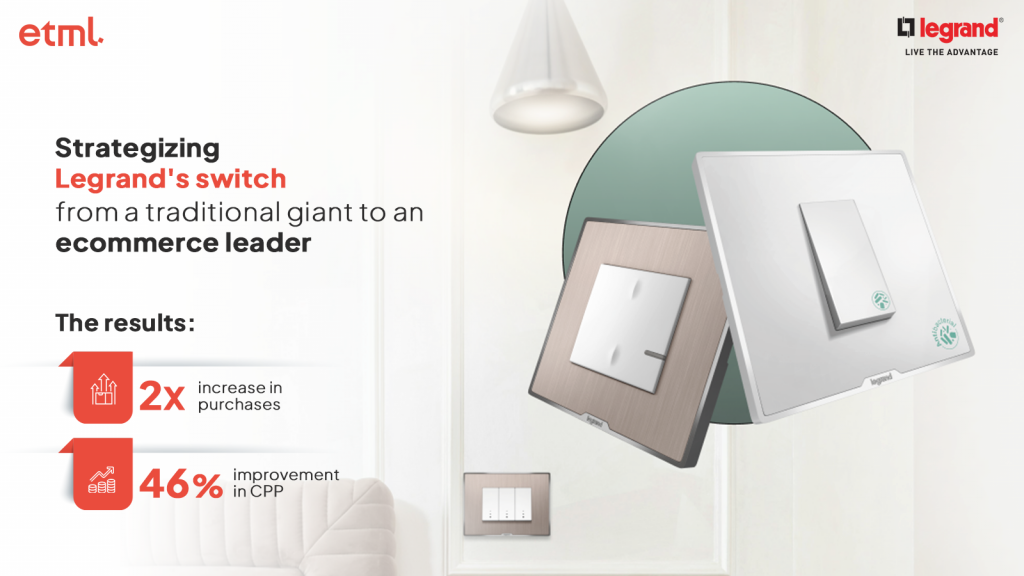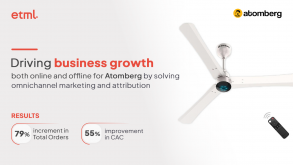
Table of Contents
Legrand’s e-commerce revolution: Navigate the digital shift of their 0-1 online journey from establishing their e-shop to having a successful sales funnel by bridging the digital gaps
Legrand, a global leader in electrical and digital building infrastructure, has dominated India’s electrical solutions market for over two decades, particularly with their innovative switches. During their initial online journey, Legrand faced challenges in developing a concrete strategy and bridging digital skill gaps. The primary goals included driving high-quality traffic, increasing sales and order volume, and reducing Cost Per Purchase (CPP). ETML addressed these challenges through a holistic approach, targeting high-intent audiences, optimizing the funnel, and enhancing creatives and the website to drive growth.

Major highlights include :
- Transitioning from a traditional market leader to an e-commerce pioneer.
- Developing a concrete online strategy and bridging digital skill gaps.
- Holistic approach targeting high-intent audiences.
- Creative and website optimization through continuous audits.
- Custom intent audiences as a game changer in PMax campaigns.
- Category expansion and lead generation campaigns for specialized segments like Home Automation.
- Use of Adbytzz for real-time dashboards and data-driven strategies.
Click here to read the full case study
1. INDUSTRY BUZZ:
Google cancels plans to kill off cookies for advertisers
Originally slated for elimination by 2022, the tech giant faced significant pushback from advertisers and regulatory hurdles. Instead of a complete ban, Google will now introduce a new system that offers users more control over their data and how it’s used for targeted advertising. While this decision aims to balance privacy concerns and industry needs, its full impact on the digital advertising landscape remains to be seen. Critics argue that this move prioritizes Google’s advertising revenue over user privacy, while others believe it provides a more nuanced approach to data protection.
72% small, medium businesses are investing in advertising: Study conducted by Amazon
A new study by market-research agency Opinium for Amazon Ads reveals a strong focus on advertising among Indian small and medium businesses (SMBs). 72% of Indian SMBs surveyed are actively advertising, with 85% reporting success in customer acquisition. However, cost remains a barrier for some, with 28% opting out due to budget limitations and ROI concerns. Despite challenges like budget allocation (30%) and content creation (36%), many businesses, like dental-care company Perfora, see advertising as crucial for growth, utilizing online platforms like Amazon, Google, and Meta for performance-driven campaigns.
Google Ads makes broad match default for new search campaigns
Google Ads has made broad match the default setting for new Search campaigns, a shift that could impact advertisers. While this simplifies setup for beginners, it increases the risk of higher costs and irrelevant clicks for those accustomed to more precise targeting. Experienced advertisers must be vigilant to prevent budget overruns due to broad match’s wider reach.
YouTube’s unblockable ads seen again as Google changes stance on extensions
Despite a crowded streaming market, YouTube remains the global leader. Recent updates include interface improvements, a focus on YouTube Shorts, and efforts to combat ad blockers. YouTube may be taking a more aggressive approach with server-side ad injection, as evidenced by user reports of black screen segments replacing ads even when using ad blockers. This could mark a significant shift in the ongoing battle between YouTube and ad blockers.
2. ETML SPEAKS:
Running an e-commerce business is tough. Between managing inventory, crafting compelling marketing campaigns, and keeping up with the latest trends, it can feel like there just aren’t enough hours in the day. But one of the biggest challenges most online retailers face is simply getting their products seen by potential customers. Sound familiar? If you’re nodding your head right now, then this blog is for you. Click here to read more.
In today’s blended world of physical and digital experiences, consumers meticulously research a product online before heading to an offline store to make the purchase, or vice versa. This “phygital” behavior, combined with the rise of D2C brands and established online marketplaces, presents a unique challenge for e-commerce brands: where and how to allocate advertising resources in this omnichannel landscape? We recently tackled this very challenge for a leading Home Appliances brand, and in this blog, you can delve into the strategies employed to navigate the unique maze. Click here to read more.
3. DATA & ANALYTICS:
Google Ads shifts to feed labels for shopping campaigns
Google Ads is automating a significant change to its Shopping and Performance Max campaigns. In August, the platform will transition from the Country of Sale targeting method to Feed Labels, aligning more closely with Merchant Center feed structures. This shift promises to simplify campaign management for advertisers operating across multiple markets by offering greater flexibility in product organization. While the change is automatic and requires no immediate action, advertisers should familiarize themselves with Feed Labels to effectively manage their campaigns post-upgrade.
Google streamlines ad creation with Merchant center-ads integration
Google Ads has introduced a new feature allowing advertisers to directly use and enhance product images from Google Merchant Center within their ad campaigns. This integration simplifies ad creation, saves time, and potentially improves ad performance. By accessing and editing product images directly in Google Ads, advertisers can create more visually appealing campaigns.
4. GROWTH STACK:
Meta’s added a new way to incorporate offers into your ads
Meta is simplifying how brands showcase special offers in their Facebook and Instagram ads. Through an updated URL ingestion process, Meta will automatically detect existing discounts and promo codes on your website, potentially boosting ad performance. You can still edit offers within the campaign setup for added control. This aligns with Meta’s growing focus on automation, exemplified by their Advantage+ campaigns which handle most of the ad creation and targeting process. While relying on automation requires trust in Meta’s systems, this new feature could be a valuable tool for holiday season campaigns.
Mobile commerce boom: How AppsFlyer’s latest report unveils secret strategies for 2024
AppsFlyer’s latest report shows a surge in mobile commerce. iOS users are driving growth with higher spending and app installs. Remarketing during the first week post-install is crucial for long-term customer loyalty. Large Asian businesses are disrupting traditional sales patterns with aggressive iOS marketing. Overall, the mobile commerce landscape is booming, with significant opportunities for growth.



